Potřebujeme váš souhlas k využití jednotlivých dat, aby se vám mimo jiné mohly ukazovat informace týkající se vašich zájmů. Souhlas udělíte kliknutím na tlačítko „OK“.
ASTM F2346-05(2011)
Standard Test Methods for Static and Dynamic Characterization of Spinal Artificial Discs
Automaticky přeložený název:
Standardní zkušební metody pro statické a dynamické charakteristiky páteře umělých disků
NORMA vydána dne 1.12.2011
Informace o normě:
Označení normy: ASTM F2346-05(2011)
Poznámka: NEPLATNÁ
Datum vydání normy: 1.12.2011
Kód zboží: NS-53624
Počet stran: 10
Přibližná hmotnost: 30 g (0.07 liber)
Země: Americká technická norma
Kategorie: Technické normy ASTM
Kategorie - podobné normy:
Anotace textu normy ASTM F2346-05(2011) :
Keywords:
artificial intervertebral disc, dynamic test methods, spinal implants, static test methods, ICS Number Code 11.040.40 (Implants for surgery, prothetics and orthotics)
Doplňující informace
| Significance and Use | ||||||||||||||||
|
Artificial intervertebral discs are orthopaedic implants that replace degenerated natural intervertebral discs. Their function is to support the anterior column of the spine while allowing motion at the operated level. These test methods outline materials and methods for the characterization of the mechanical performance of different artificial intervertebral discs so that comparisons can be made between different designs. These test methods are designed to quantify the static and dynamic characteristics of different designs of artificial intervertebral discs. These tests are conducted in vitro in order to allow for analysis of individual disc replacement devices and comparison of the mechanical performance of multiple artificial intervertebral disc designs in a standard model. The loads applied to the artificial intervertebral discs may differ from the complex loading seen in vivo, and therefore, the results from these tests may not directly predict in vivo performance. The results, however, can be used to compare mechanical performance of different artificial intervertebral discs. Fatigue tests should be conducted in a 0.9 % saline environmental bath at 37°C at a rate of 2 Hz or less. Other test environments such as a simulated body fluid, a saline drip or mist, distilled water, or other type of lubrication could also be used with adequate justification. Likewise, alternative test frequencies may be used with adequate justification. It is well known that the failure of materials is dependent upon stress, test frequency, surface treatments, and environmental factors. Therefore, when determining the effect of changing one of these parameters (for example, frequency, material, or environment), all others should be kept constant to facilitate interpretation of the results. In particular, it may be necessary to assess the influence of test frequency on device fracture while holding the test environment, implant materials and processing, and implant geometry constant. |
||||||||||||||||
| 1. Scope | ||||||||||||||||
|
1.1 These test methods specify the materials and methods for the static and dynamic testing of artificial intervertebral discs. 1.2 These test methods are intended to provide a basis for the mechanical comparison among past, present, and future non-biologic artificial intervertebral discs. These test methods allow comparison of artificial intervertebral discs with different intended spinal locations (cervical, thoracic, and lumbar) and methods of application to the intervertebral spaces. These test methods are intended to enable the user to mechanically compare artificial intervertebral discs and do not purport to provide performance standards for artificial intervertebral discs. 1.3 These test methods describe static and dynamic tests by specifying load types and specific methods of applying these loads. These tests are designed to allow for the comparative evaluation of artificial intervertebral discs. 1.4 These test methods do not purport to address all clinically relevant failure modes for artificial intervertebral discs, some of which will be device specific. For example, these test methods do not address the implant's resistance to expulsion or implant wear resistance under expected in vivo loads and motions. In addition, the biologic response to wear debris is not addressed in these test methods. 1.5 Requirements are established for measuring displacements, determining the yield load or moment, and evaluating the stiffness of artificial intervertebral discs. 1.6 Some artificial intervertebral discs may not be testable in all test configurations. 1.7 The values stated in SI units are to be regarded as the standard with the exception of angular measurements, which may be reported in terms of either degrees or radians. 1.8 The use of this standard may involve the operation of potentially hazardous equipment. This standard does not purport to address all of the safety concerns, if any, associated with its use. It is the responsibility of the user of this standard to establish appropriate safety and health practices and determine the applicability of regulatory limitations prior to use. |
||||||||||||||||
| 2. Referenced Documents | ||||||||||||||||
|
Podobné normy:
Historická
1.10.2013
Historická
1.5.2008
Historická
1.8.2009
Historická
1.11.2013
Historická
1.6.2013
Historická
1.1.2012
Doporučujeme:
Aktualizace technických norem
Chcete mít jistotu, že používáte pouze platné technické normy?
Nabízíme Vám řešení, které Vám zajistí měsíční přehled o aktuálnosti norem, které používáte.
Chcete vědět více informací? Podívejte se na tuto stránku.


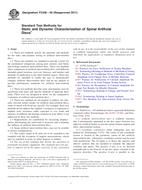
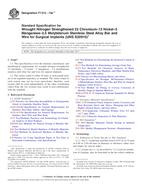 ASTM F1314-13ae1..
ASTM F1314-13ae1..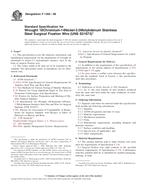 ASTM F1350-08
ASTM F1350-08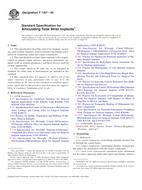 ASTM F1357-09
ASTM F1357-09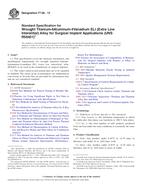 ASTM F136-13
ASTM F136-13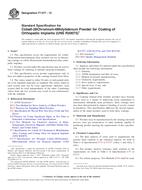 ASTM F1377-13
ASTM F1377-13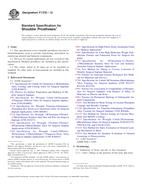 ASTM F1378-12
ASTM F1378-12
 Cookies
Cookies
